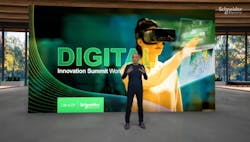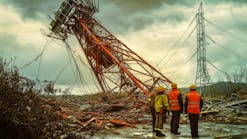Schneider Electric Innovation Summit: The Future requires Smaller, Faster, Smarter, Cleaner
Let’s get small. And nimble. And efficient.
Once a punchline for comics, the first part of that lead takes on added resonance and seriousness in the electric grid world as much of power generation moves away from centralized plants. The move now is racing toward diffusion, or diff-fusion, a fragmenting of the electricity structure that is smaller, yes, but also fusing together distributed resources such as renewables, battery storage, digitalization, electric vehicles and an emphasis on greater visibility into that ever-moving, elusive electron.
That’s scary...and electrifying.
The pivotal era of aggregating and organizing multiple points of cleaner, lower-carbon energy--rather than rely on one fossil-based source--was in full flower at the Schneider Electric Innovation Summit last week in Las Vegas. The event was Schneider’s first North American summit in person since Atlanta in 2018, due to the COVID-19 pandemic.
The world has changed much since then, and yet the needs are the same as they were four years ago.
“The first step is to understand your energy use,” Michael Mahan, vice president of SE’s home & distribution line of business, said in a press session at the Las Vegas summit. “Then you can start to understand your carbon footprint.”
Knowledge is power, as the age-old adage goes, and that’s no less relevant with energy efficiency than any other line of work. In Las Vegas, an array of next-gen energy thinkers and doers highlighted how the information age of energy—driven by artificial intelligence, analytics and management controls—will illuminate an uncertain road forward with intermittent renewables and an aging grid balanced against a predicted three-fold growth in energy demand.
For the long-term, the pace of climate change must drive choices on the road to net zero carbon emissions in coming decades.
“I haven’t been to a place without a drought” or somehow impacted by extreme weather in recent years,” Schneider Electric CEO Jean-Pascal Tricoire (pictured from another talk) said in a second-day keynote at the host Resorts World venue. “There is massive pressure from investors, regarding ESG (the environmental, social and governance aims of companies). If you want to attract good people, you need to have a plan for sustainability.”
In the short-term, the Biden Administration’s recently passed and signed Inflation Reduction Act was all the talk at the Innovation Summit, with so much excitement built up around its $369 billion in funding for clean energy technologies, a figure that Credit Suisse estimated will really amount to more than $800 million worth of impact once multipliers and co-investment are put in place.
“It is absolutely game changing,” said Kevin Self, Schneider Electric’s leader for strategy, government policy and regulatory affairs. He noted that, despite some skepticism of how fast it will take to start see the funding, close to $10 billion is already pouring into the system, and that pace will pick up quickly.
That’s incentives and credits to spur projects around not only renewables, but also EV charging and adoption, energy efficiency in buildings, microgrids and battery storage. These projects will gather momentum in coming years, thanks to the IRA passage, experts said in Las Vegas.
“It is enduring,” Melanie Nakagawa, a former Biden Administration official on climate issues who helped push some of the bill’s ideas and language forward. “This is no Biden Administration thing that ends at a certain date. Expect this law to be in the system generating tailwinds for many years to come.”
The movement to lift uup lower carbon-emitting, distributed energy resources to private sector dominance isn’t credited purely to the Biden Administration’s push. The Federal Energy Regulatory Commission’s Order 2222, which happened during the Trump era and included many of his FERC appointees, set the path to remove barriers for aggregators of DERs to compete in regional wholesale electric markets.
One the private sector’s fast-rising aggregators is AutoGrid, which was acquired by Schneider Electric earlier this year. AutoGrid’s Virtual Power Plant (VPP) technology aggregates customer-owned energy storage, on-site renewables and demand response tools to barter excess energy into multiple energy markets and create both balance and flexibility for grids often in duress by high demand and uncertain capacity.
Rahul Kar, AutoGrid’s senior vice president and general manager, noted that the near future grid will be connected to countless new projects from rooftop solar to EV charging stations both residential and commercial, battery storage both utility-scale and home-sized. All of it will need some forward-predicting and responsive market acumen.
“Lots of infrastructure is getting deployed,” Kar pointed out. “You need a layer to bring all those assets together.”
AutoGrid aggregates GW of capacity in markets such as Hong Kong, India and Texas. The ability to move energy around, and balance it, has helped avoid widespread grid outages during high-demand and extreme weather events.
“We don’t own the assets, but we can bring all the elements together (to create capacity) and avoid (gas-fired) peaker plants,” he said during a few moments with EnergyTech at the Schneider Electric Innovation Summit.
Some longtime grid analysts worry about these grid-edge tools, using both the power lines and the internet, because of cybersecurity as well as physical concerns that the VPP won’t be there when you need it most. Kar turns the argument around, pointing simply to the Texas grid catastrophe of February 2022, when some 52 GW of capacity was knocked offline by freezing weather, including an unprecedented level of unavailable natural gas wellhead and gas-fired power.
“The truth is, you can’t depend on a natural gas plant,” Kar pointed out.
The truth is, he continued, the future is wide open and positive with cleaner, smaller and diffused generation. Government help from the Inflation Reduction and Infrastructure Acts, as well as FERC Order 2222, can grease the wheels of commerce to do what it does best and innovate.
“Get the smaller aggregators involved,” Kar said. “You don’t need to put in large power plants anymore.”
The Schneider Electric Innovation Summit in Las Vegas was clearly focused on that brave world of future diffusion and digitalization of the power grid. Getting smaller, it wagers, will pay off big in the long run.
The future looks brighter, but it needs to start yesterday and never take the foot off the accelerator.
“Clearly today, we’re not where we need to be,” CEO Tricoire also said in his keynote. “We need to do three times more, three times faster.”
-- -- --
(Rod Walton, senior editor for EnergyTech, is a 14-year veteran of covering the energy industry both as a newspaper and trade journalist. He can be reached at [email protected]).
Follow us on Twitter @EnergyTechNews_ and @rodwaltonelp and on LinkedIn





